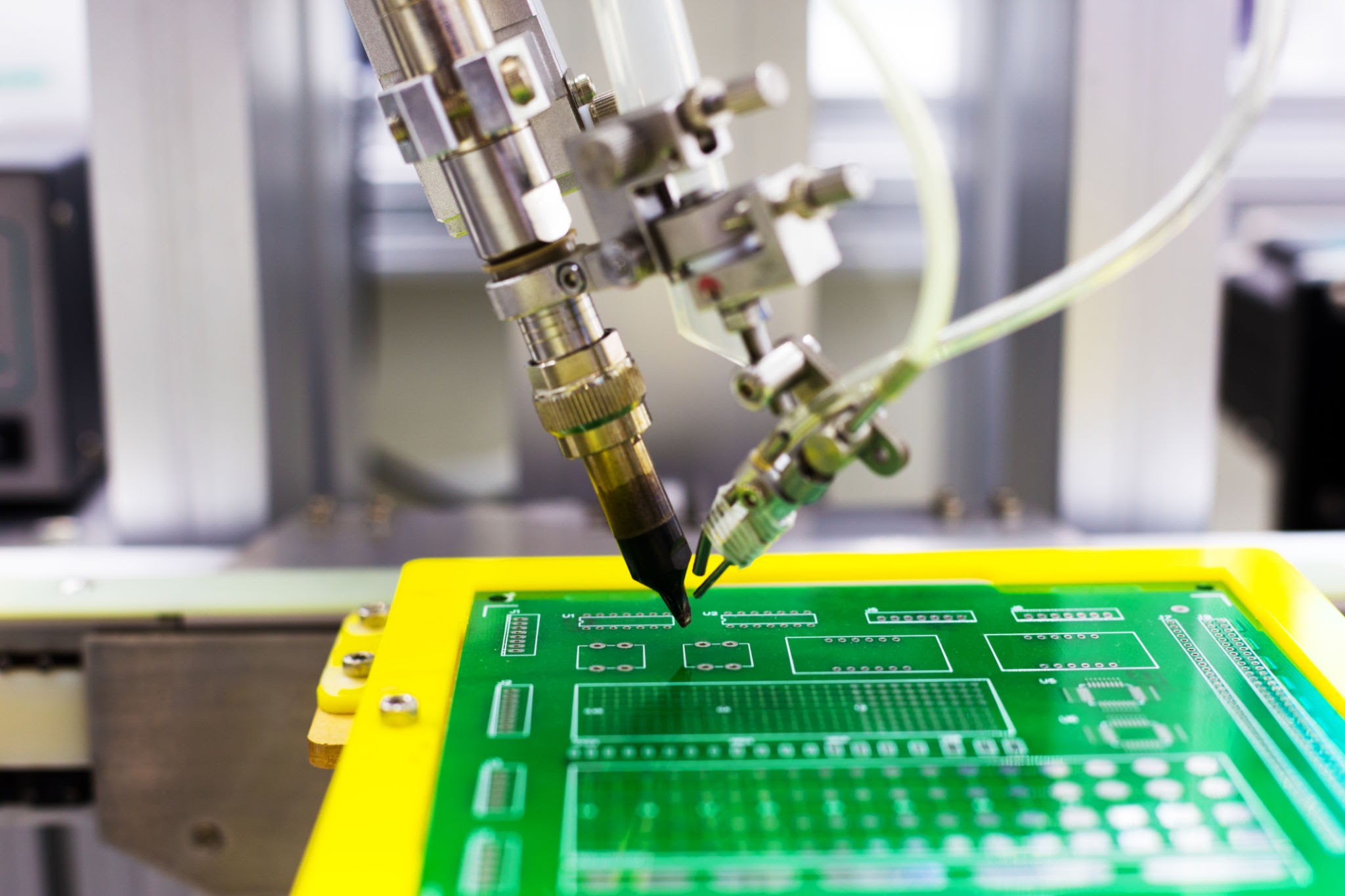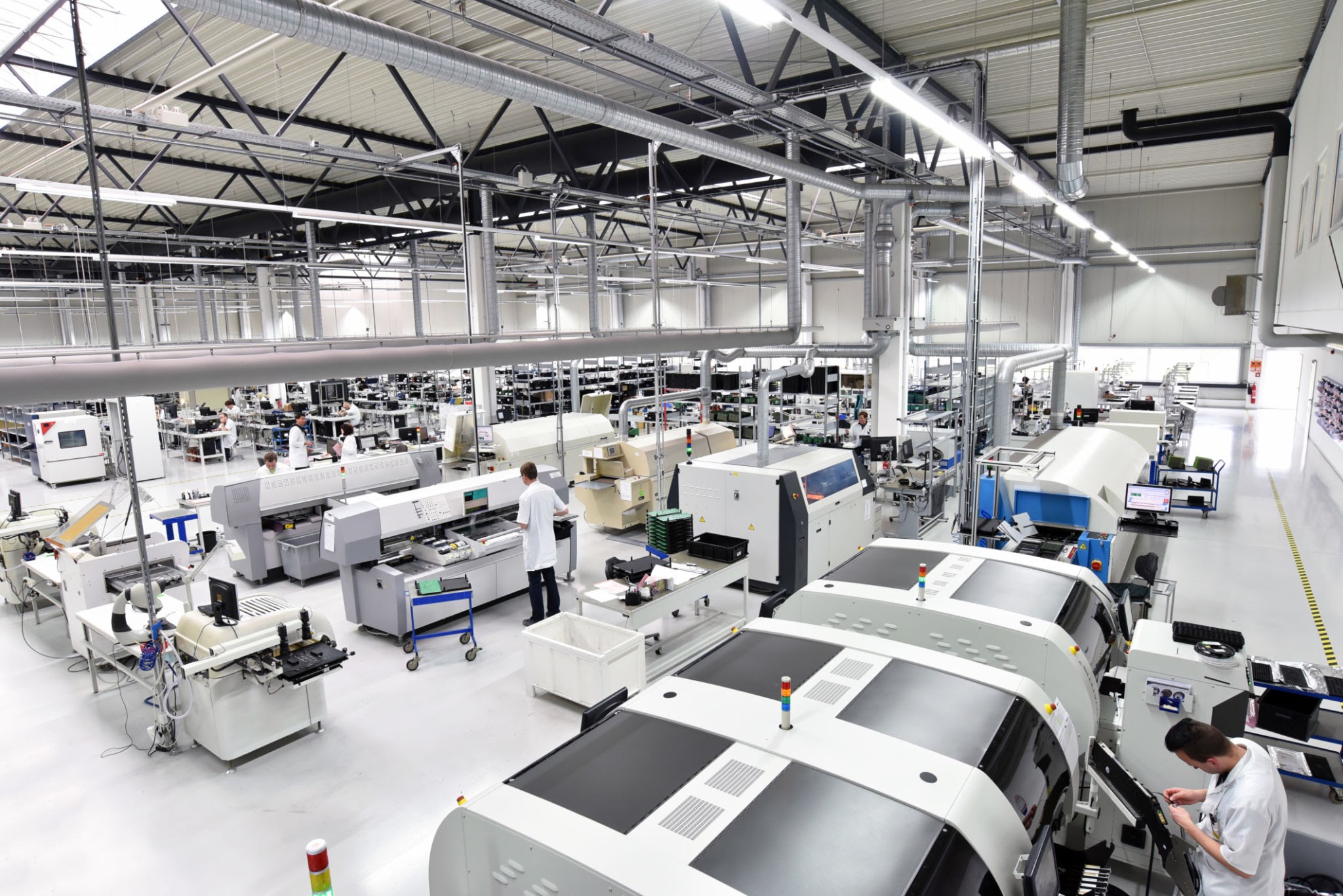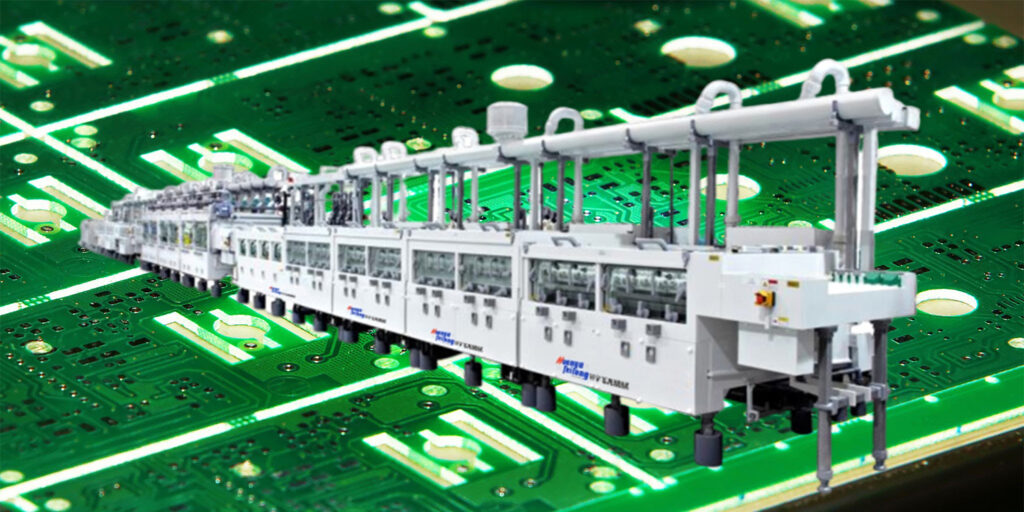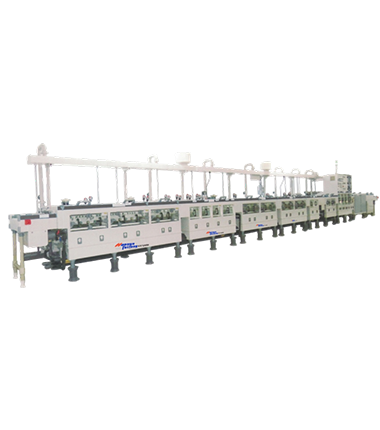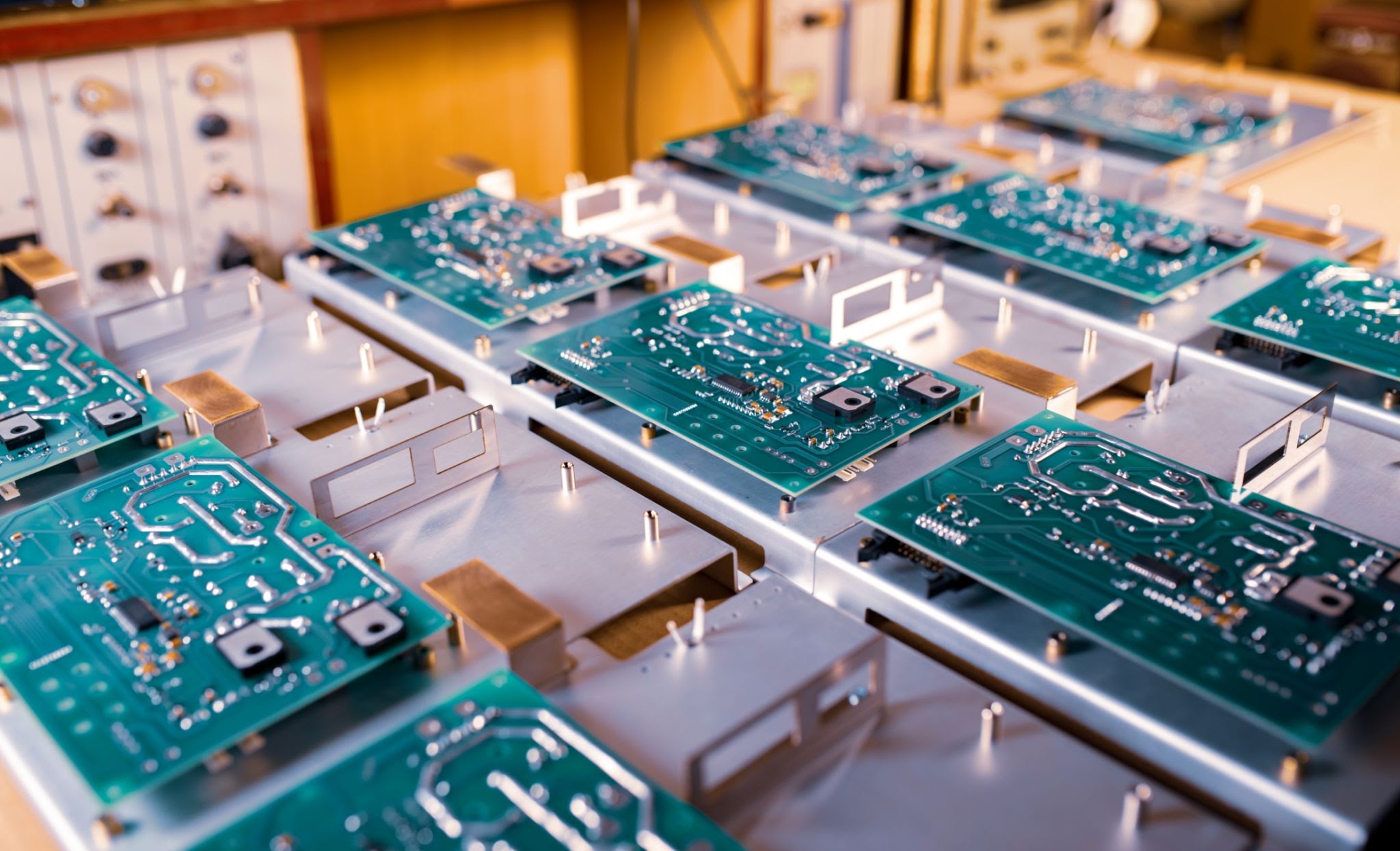- PCB Etching Machine: From Dragon Etching
- Purpose: PCB etching machines are used to selectively remove unwanted copper from the surface of a copper-clad board to create the desired circuit pattern.
- Process:
- The PCB is first cleaned to remove any contaminants.
- A layer of photoresist is applied to the board’s surface.
- A photomask, containing the desired circuit pattern, is aligned and placed on the board.
- The board is exposed to UV light, which hardens the photoresist in areas not covered by the mask.
- The etching machine sprays an etchant (e.g., ferric chloride) onto the board, which dissolves the exposed copper, leaving behind the circuit traces.
- After etching, the remaining photoresist is stripped to reveal the clean copper traces.
- Key Components: The machine includes a conveyor system for transporting boards, nozzles for uniform etchant distribution, and chemical control systems to monitor and control the etching process parameters like temperature, flow rate, and immersion time.
- PCB Cleaning Machine: From Dragon Etching
- Purpose: PCB cleaning machines are essential for removing various contaminants and residues from the surface of printed circuit boards.
- Process:
- The PCB is placed on a conveyor system that passes it through a series of cleaning stages.
- Typically, the first stage involves a pre-cleaning step to remove heavy contaminants.
- Subsequent stages employ ultrasonic cleaning baths, chemical cleaning agents, and brushes or nozzles to thoroughly clean the board’s surface.
- Rinse cycles follow to remove cleaning agents and residues.
- Drying mechanisms, such as hot air or infrared heating, ensure the board is completely dry.
- Key Components: These machines consist of conveyor belts, cleaning tanks, brushes or nozzles for cleaning agents, drying mechanisms, and filtration systems to maintain the cleanliness of cleaning solutions.
- PCB Developing Machine: From Dragon Etching
- Purpose: PCB developing machines are used to develop the exposed photoresist on a PCB, revealing the circuit pattern.
- Process:
- The PCB is loaded onto a conveyor or rack system.
- It is then passed through a developer bath that contains a developer solution (typically alkaline) which removes the unexposed photoresist.
- The time of immersion and the temperature of the developer solution are carefully controlled to achieve the desired development.
- After developing, the board is rinsed to remove any residual developer.
- Key Components: Key components include developer baths, conveyor systems, and temperature control units for precise process control.
- PCB Stripping Machine: From Dragon Etching
- Purpose: PCB stripping machines are used in semiconductor manufacturing to remove photoresist or other unwanted layers from wafers.
- Process:
- The machine can use chemical processes, such as wet etching or solvent stripping, or mechanical methods, like abrasive brushing, to remove the unwanted layers.
- The choice of method depends on the specific application and material to be stripped.
- Key Components: Components may include chemical tanks, spray nozzles, and mechanical components for stripping, as well as exhaust systems to handle chemicals safely.
- PCB Grinding Machine: From Dragon Etching
- Purpose: PCB grinding machines are used in semiconductor manufacturing to grind and polish silicon wafers for flatness and smoothness.
- Process:
- Wafers are mounted on a rotating chuck.
- Abrasive materials (such as diamond grinding wheels) are used to remove material from the wafer’s surface.
- Precision control systems ensure uniform grinding and polishing.
- Key Components: Key components include the rotating chuck, abrasive materials, and precision control systems for grinding parameters.
- PCB Through-Hole Plating: From Dragon Etching
- Purpose: Through-hole plating machines are used in PCB manufacturing to add a metal layer to through-holes in a printed circuit board, creating a conductive path.
- Process:
- The PCB is first cleaned and prepared.
- It is then immersed in an electroplating bath containing a metal solution (typically copper).
- An electrical current is applied to deposit the metal layer inside the through-holes.
- After plating, the board is rinsed and dried.
- Key Components: Components include electroplating baths, cathodes, anodes, and control systems for regulating plating parameters, as well as rinse and drying stations.
- PCB Drilling Machine: From Dragon Etching
- Purpose: PCB drilling machines create holes for component leads and vias in printed circuit boards.
- Detailed Workflow:
- Load the PCB onto the machine’s worktable.
- Program the CNC control system with coordinates for the holes to be drilled.
- Select the appropriate drill bits based on hole size requirements.
- The machine’s high-speed spindle begins drilling holes according to the programmed coordinates.
- Automatic tool changes may occur if different hole sizes are needed.
- Once all holes are drilled, the PCB is removed from the machine.
- Key Components: Precision drill bits, CNC control system, worktable.
- PCB Routing Machine (PCB Router):
- Purpose: PCB routing machines trim excess PCB material and separate individual boards from a larger panel.
- Detailed Workflow:
- Load the PCB onto the routing machine.
- Program the CNC control system with the desired cutting paths.
- The machine’s rotating routing bits follow the programmed paths, precisely cutting the PCB.
- As each PCB is cut from the panel, it is moved to a separate collection area.
- Key Components: Routing bits, CNC control software, worktable.
- Recommended URL: PCB Routing Techniques
- Solder Paste Printing Machine:
- Purpose: Solder paste printing machines deposit solder paste onto PCBs before component placement.
- Detailed Workflow:
- Place a stencil over the PCB with openings corresponding to solder pad locations.
- Apply solder paste over the stencil.
- A squeegee spreads the solder paste evenly across the stencil.
- Excess solder paste is scraped away, leaving only paste in the stencil openings.
- Remove the stencil, leaving solder paste on the PCB.
- Key Components: Stencils, squeegees, alignment systems.
- Recommended URL: Solder Paste Printing Overview
- Pick and Place Machine:
- Purpose: Pick and place machines automatically position surface-mount components onto PCBs.
- Detailed Workflow:
- The vision system identifies component positions on feeders.
- Robotic arms with vacuum nozzles pick up components from the feeders.
- The machine accurately places components onto the PCB based on programmed coordinates.
- Components are placed at high speeds, with vision systems ensuring precision.
- PCBs move through the machine, and components are placed in the desired locations.
- Key Components: Robotic arms, vision systems, feeders.
- Recommended URL: Pick and Place Machines
- Reflow Oven:
- Purpose: Reflow ovens melt solder paste to create solder joints between components and PCBs.
- Detailed Workflow:
- PCBs with solder paste and components enter the oven on a conveyor belt.
- The oven has multiple temperature-controlled zones.
- In the preheat zone, the temperature gradually rises to activate the flux in the solder paste.
- In the reflow zone, the solder paste reflows, forming solder joints.
- Cooling zones gradually reduce the temperature to solidify the solder joints.
- PCBs exit the oven with properly formed solder joints.
- Key Components: Heating elements, conveyor systems, temperature controllers.
- Recommended URL: Reflow Soldering Basics
Category Archives: PCB
Essential Equipment for Opening a PCB Manufacturing Plant
With the growing demand for electronic devices and technology, the need for printed circuit boards (PCBs) has skyrocketed. If you are considering venturing into the electronics manufacturing industry and want to open a PCB manufacturing plant, equipping your facility with the right tools is crucial for success. This article will guide you through the essential equipment required to set up a state-of-the-art PCB manufacturing plant.
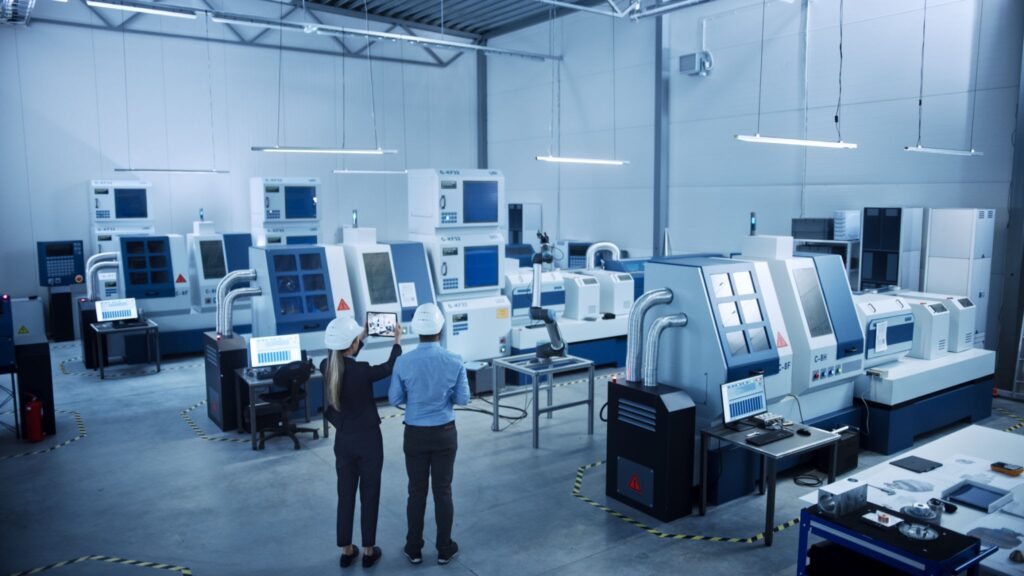
- PCB Design Software:
Before diving into production, you’ll need reliable PCB design software to create and optimize your circuit layouts. Numerous software options are available, ranging from user-friendly to advanced, offering various features like auto-routing, design rule checks (DRC), and schematic capture. Select a tool that suits your team’s proficiency and design complexity.
- CAM Software:
Computer-Aided Manufacturing (CAM) software is essential to convert your PCB designs into machine-readable formats. This software ensures that the PCB manufacturing equipment understands and executes the design accurately during the production process.
- PCB Fabrication Equipment:
a. CNC Machines (Drilling Machines): CNC (Computer Numerical Control) drilling machines are used to create holes for component placement and vias on the PCB. Choose machines that offer high precision and speed to streamline the manufacturing process.
b. Etching Equipment: Etching is a crucial step in PCB manufacturing where unwanted copper is removed from the board surface. Acid etching and chemical-free methods (using plasma or lasers) are common techniques. Select the appropriate equipment based on your production scale and environmental concerns.
c. Laminators: Laminators are used to apply dry film resist and copper layers onto the PCB substrate. This step is vital in creating the circuit pattern for subsequent etching.
d. Exposure Units: Exposure units utilize UV light to transfer the PCB design’s image onto the photosensitive film or resist-coated board before etching. Consistent exposure is essential for high-quality PCBs.
- Soldering and Assembly Equipment:
a. Pick-and-Place Machines: Automated Pick-and-Place machines accurately position and solder surface-mount components onto the PCB. These machines significantly enhance productivity and placement accuracy.
b. Reflow Ovens: Reflow ovens are used to melt the solder and secure the components on the PCB during the soldering process. Proper temperature profiles are crucial to avoid defects.
c. Wave Soldering Machines: For through-hole components, wave soldering machines are used to create solder connections simultaneously on multiple pins.
- Testing and Quality Control:
a. Automated Optical Inspection (AOI) Systems: AOI systems perform visual inspections of assembled PCBs, identifying defects such as missing components, misalignment, or soldering issues.
b. Flying Probe Testers: Flying probe testers are employed for functional testing of PCBs. They use movable probes to check connectivity and circuit performance.
- Environmental Controls and Safety Equipment:
a. Cleanrooms: PCB manufacturing demands a dust-free and controlled environment. Cleanrooms ensure that airborne contaminants do not affect the quality of your boards.
b. Safety Equipment: Ensure your employees have access to personal protective equipment (PPE) such as goggles, gloves, and face masks to guarantee their safety during manufacturing.
PCB Equipment List
| Depart. | Process | Equipment |
|---|---|---|
| PE Engineer | File Input | Frontline InPlan Planning Software |
| CAM | Orbotech InCAM | |
| A/W | Orbotech photo plotter | |
| Inner Layer | Inner Film | Automatic Wet Film Coater |
| Inner Exposure | Various manual and semi-auto exposure | |
| Inner Layer Etch | Universal DES( Develop-Etch-Strip) Lines | |
| AOI Inspection | Orbotech Discovery, Camtek | |
| Brown Oxide | Universal Alternative Oxide Line | |
| Laminating | Burkle, OEM, Heng-da Vacumm Presses | |
| Drilling | Mechnical Drill | Hitachi, Schmoll, HanStar |
| Laser Drill | Mitsubishi Laser Drill | |
| Ourer Layer | Plasma Clean | ReBorn RPP-V13 |
| PTH | Automatic Desmear and Electroless Copper | |
| Semi-Exposure | 5KW Manual Exposure | |
| LDI machine | Laser Direct Imaging photeck | |
| Pattern Palting | Automatic Panel Plating Line | |
| Automatic Pattern Plating Line | ||
| MCP-PAL Vertical Continuous Plating Line | ||
| Copper Via Fill Plating Tank | ||
| Outer Layer Etch | Universal SES( Strip-Etch-Tin Strip) Line | |
| SM & Marking | SM Printing | Horizontal Semi Automatic Coater |
| SM Exposure | Various SM Exposure | |
| Legend | Sprint 100 | |
| Ourline | CNC | CNC Routers + CCD routers |
| V-Cut | CNC V-score | |
| Punch Die | Punch | |
| Chamfer | Bevel | |
| Surface finish | HASL | Tin/Lead HASL |
| Leadfree Hasl | Lead Free HASL | |
| ENIG | Uyemura | |
| ENEPIG | Successful | |
| Imm. Ag | MacDermid(Planar) | |
| Imm. Tin | Atotech(Stannatech) | |
| ENTEK | OSP | |
| Hard FGold | Full body gold, gold fingers and selective gold | |
| Flash Gold | Full body and selevtive bondable soft gold | |
| Test & Inspection | E-T Fixture | 2wire / 4wire Fxiture Test |
| Flying Probe | 2wire / 4wire Flying Probe Test | |
| Reliability Test | X-section and Microscopes, Impendence Test, High-Pot, | |
| Tg Test, Peel Strength, lonic Testing, IR Reflow, Thermal Chamber etc chrommotography,IST,CAF | ||
Mastering the Chemistry: Hydrofluoric Acid (HF) in PCB Wet Etching
In the world of PCB manufacturing, precision and control are paramount in crafting intricate circuit patterns. One of the most potent and challenging chemical solutions utilized in the wet etching process is Hydrofluoric Acid (HF). Composed of hydrogen and fluorine, HF is a highly corrosive and hazardous acid known for its ability to dissolve various materials, including glass and metals. In this blog, we will delve into the specifics of Hydrofluoric Acid (HF) and provide valuable details on its technique for use in PCB wet etching machines, emphasizing safety and precision.
In the field of chemistry Hydrofluoric Acid belongs to which category?
Inorganic Fluxes
Inorganic fluxes are highly corrosive, and are comprised of inorganic acids and salts such as hydrochloric acid, hydrofluoric acid, stannous chloride, sodium or potassium fluoride, and zinc chloride. These fluxes are capable of removing oxide films of ferrous and nonferrous metals such as stainless steel, Kovar and nickel irons, which cannot be soldered with weaker fluxes.
Inorganic fluxes generally are used for nonelectronics applications such as the brazing of copper pipes. They are, however, sometimes used for lead-tinning applications in the electronics industry. Inorganic fluxes should not even be considered for electronics assemblies (conventional or surface mount) because of potential reliability problems. Their major disadvantage is that they leave chemically active residues than can cause corrosion and serious field failures.
Performance criteria for chemical milling
photoresists are in many ways more demanding than those of PWB fabricators; there is aplethora of different substrates such as Alloy 42,beryllium copper, iron-nickel alloys, molybdenum, tungsten, Invar, and many more. Theetching chemistries and etch conditions, which the resist must survive, are brutal. In addition to the more benign cupric chloride and the mainstream ferric chloride, you find mixtures of hydrofluoric and nitric acid which embrittle the resist, as well as very highly alkaline solutions of potassium ferrocyanide, which act like strippers on aqueous processable resists.
What is Hydrofluoric Acid (HF)?
Hydrofluoric Acid (HF) is a strong, colorless liquid acid with the chemical formula HF. Due to its reactivity and corrosiveness, HF is typically used with caution in specialized applications, such as glass etching, metal cleaning, and semiconductor manufacturing. In PCB wet etching, HF is employed to selectively remove silicon dioxide (SiO2) or glass passivation layers from semiconductor devices, enabling the creation of specific circuit patterns.
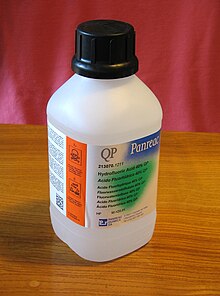
Technique of Using Hydrofluoric Acid (HF) for PCB Wet Etching:
- Preparing the HF Solution:
To prepare the HF etchant solution, dilute the concentrated HF with deionized water to achieve the desired concentration. The concentration of HF is typically expressed in percentage (%). Common concentrations for PCB wet etching are around 5% to 10% HF.
- Personal Protective Equipment (PPE):
Safety is paramount when handling HF. Always wear appropriate Personal Protective Equipment (PPE), including acid-resistant gloves, a full-face shield, chemical-resistant apron, and safety goggles to protect against splashes and inhalation of vapors.
- Proper Ventilation:
Always work with HF in a well-ventilated area or under a fume hood to prevent exposure to its toxic and corrosive vapors.
- Etching Temperature:
The etching temperature can significantly impact the etch rate and selectivity. Typically, HF etching is conducted at room temperature (around 20°C to 25°C) to ensure precision and consistency.
- Immersion Time:
The immersion time in the HF etchant solution determines the depth of etching. Longer immersion times result in deeper etching, while shorter times yield shallower patterns. The immersion time should be carefully controlled based on the desired circuit design and the thickness of the SiO2 or glass passivation layer.
- Agitation:
Gentle agitation of the etchant solution can promote an even distribution of the HF across the substrate’s surface, ensuring uniform and precise etching results.
- Neutralization and Disposal:
HF should not be neutralized with alkaline substances, as this can produce toxic and corrosive fluoride salts. Instead, HF should be treated with specific HF neutralizing agents. After etching, the spent HF solution should be carefully collected and disposed of according to environmental regulations.
Conclusion:
Hydrofluoric Acid (HF) is a powerful tool in PCB wet etching, enabling engineers to achieve precision and control in crafting intricate circuit patterns. By adhering to proper safety protocols and technique, HF can be handled with confidence, and PCB manufacturers can create high-quality and reliable electronic devices. Embrace the chemistry of HF, and elevate your PCB manufacturing process to new heights of accuracy and excellence.
As a wet process engineer, mastering the use of Hydrofluoric Acid (HF) in PCB wet etching empowers you to create cutting-edge electronic devices with flawless circuitry, revolutionizing the world of technology. Happy etching!
Unleashing the Potential of Ferric Chloride Etchant in PCB Wet Etching: A Comprehensive Guide
In the realm of printed circuit board (PCB) manufacturing, the etching process plays a pivotal role in shaping intricate circuit patterns. Among the array of etchants available, Ferric Chloride Etchant stands out as a reliable and efficient solution. Composed of ferric chloride (FeCl3), this chemical marvel offers engineers unparalleled control and precision during wet etching. In this blog, we will delve into the specifics of Ferric Chloride Etchant and provide valuable tips for its effective utilization in PCB wet etching machines.
What is Ferric Chloride Etchant?
Ferric Chloride Etchant is an acidic solution containing ferric chloride, a potent chemical compound known for its exceptional ability to dissolve copper effectively. This unique etchant is widely employed in the PCB manufacturing industry for its excellent selectivity, allowing for the precise removal of copper from the PCB substrate without adversely affecting other materials.
What Could Ideal Etch Factors Mean for SAP?
If somehow you could get both the regeneration of cupric chloride and the vertical sidewalls of powderless ferric chloride etching, I think we would see a dramatic change in the PCB industry. Currently, using the semi-additive process (SAP) is the most practical way to obtain fine features. However, if sideways etch can be efficiently inhibited in the etchants we use today (cupric chloride and alkaline cupric chloride), SAP may not even be necessary in most cases. If you are unfamiliar with SAP, it can be summarized as a process where a copper-plated panel undergoes a selective plating process to form desired features on top of the copper that was already present. Once the features are plated onto the base copper, that panel gets etched to remove the base copper, thus leaving behind only the features that were added. Finding a way around SAP would mean skipping many long and costly steps in the PCB fabrication process. Without requiring SAP to obtain fine features, PCB shops would require less plating equipment and fewer resources to perform plating (i.e., chemicals, trained personnel, time to plate, and operating space).

The Technique of Using Ferric Chloride Etchant in PCB Wet Etching Machine:
- Etchant Preparation:
To prepare the Ferric Chloride Etchant solution, dissolve ferric chloride crystals in water. The recommended ratio is typically one part ferric chloride to three parts water, by weight. Always add the ferric chloride slowly to the water while stirring, and ensure you work in a well-ventilated area with proper safety equipment.
- Temperature Control:
Maintaining the etchant at the ideal temperature is vital for achieving consistent and accurate etching results. The recommended operating temperature for Ferric Chloride Etchant typically ranges from 35°C to 45°C (95°F to 113°F). Consider using a temperature-controlled wet etching machine to ensure precise regulation.
- Immersion Time:
The etching time directly influences the depth of copper removal. Longer immersion times result in deeper etching, while shorter durations yield shallower patterns. The immersion time can vary depending on the desired circuit design and the thickness of the copper layer.
- Agitation:
Proper agitation of the etchant solution is essential for promoting an even distribution of the etchant across the PCB surface. Adequate agitation prevents over-etching or under-etching, ensuring uniformity in the etching process.
- Neutralization and Disposal:
After completing the etching process, neutralize the Ferric Chloride Etchant to deactivate it and render it safe for disposal. Utilize a neutralizing agent, such as sodium bicarbonate (baking soda), to neutralize the etchant solution before disposing of it responsibly according to environmental regulations.
- Safety Precautions:
Ferric Chloride Etchant is corrosive and can cause skin and eye irritation. Always wear appropriate personal protective equipment (PPE), such as gloves and safety goggles, and work in a well-ventilated area to avoid exposure to fumes.
Ferric Chloride Etchant is a powerful ally in the PCB wet etching process, offering precision, control, and efficiency. By following the proper technique for its preparation and usage, engineers can create intricate circuit patterns with confidence. Embrace the potential of Ferric Chloride Etchant, and elevate your PCB manufacturing process to new heights of accuracy and excellence.
As a wet process engineer, your mastery of Ferric Chloride Etchant will undoubtedly contribute to the success of PCB manufacturing, ushering in a new era of advanced electronic devices with flawless circuitry. Happy etching!
Mastering the Art of Cupric Chloride Etchant in PCB Wet Etching: A Step-by-Step Guide
In the realm of printed circuit board (PCB) manufacturing, Cupric Chloride Etchant stands as a powerful ally in achieving precision and control during the wet etching process. This chemical solution, composed of cupric chloride (CuCl2), enables engineers to selectively remove copper from PCB substrates, shaping intricate circuit patterns. In this blog, we will delve into the specifics of Cupric Chloride Etchant and provide valuable tips for its effective utilization in PCB wet etching machines.
What is Cupric Chloride Etchant?
Cupric Chloride Etchant is an acidic solution containing cupric chloride, a chemical compound known for its ability to dissolve copper efficiently. This etchant is widely used in the PCB manufacturing industry for its excellent selectivity, allowing for precise copper removal without adversely affecting other materials on the PCB.
Tips for Using Cupric Chloride Etchant in PCB Wet Etching Machine:
- Etchant Preparation:
To prepare the Cupric Chloride Etchant solution, mix cupric chloride crystals with hydrochloric acid (HCl) in a proper ratio. The common ratio is approximately 100 grams of cupric chloride per 100 milliliters of concentrated hydrochloric acid. Always add the acid to the water slowly while stirring, and ensure you’re working in a well-ventilated area with proper safety equipment.
- Temperature Control:
Maintaining the right temperature is crucial for achieving accurate etching results. The ideal operating temperature for Cupric Chloride Etchant typically ranges from 35°C to 50°C (95°F to 122°F). Consider using a temperature-controlled wet etching machine to ensure precise regulation.
- Immersion Time:
The etching time is directly related to the depth of copper removal. Longer immersion times result in deeper etching, while shorter times yield shallower patterns. The immersion time can vary depending on the desired circuit design and the thickness of the copper layer.
- Agitation:
Gentle agitation of the etchant solution can enhance the etching process by promoting even distribution. Proper agitation helps prevent over-etching or under-etching and ensures uniformity across the PCB surface.
- Neutralization and Disposal:
After the etching process, neutralize the Cupric Chloride Etchant to ensure it is deactivated and rendered safe for disposal. Utilize a neutralizing agent, such as sodium carbonate (Na2CO3), to neutralize the etchant solution before disposing of it responsibly according to environmental regulations.
- Safety Precautions:
Cupric Chloride Etchant is corrosive and toxic, requiring careful handling. Always wear appropriate personal protective equipment (PPE), work in a well-ventilated area, and follow proper safety protocols to avoid accidents and exposure to harmful fumes.
About Cupric and Alkaline
Together, these etchants are used in the majority of PCB etch shops, with alkaline being the most popular. To provide a baseline of how they work, their etch reactions along with their corresponding regeneration reactions, can be found in Table 1.
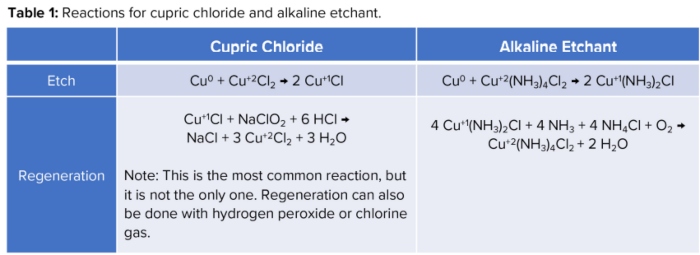
One of the main reasons these two etchants are the most used is because of their regeneration capabilities. With regeneration, you increase the capacity of copper you can etch. It also helps keep the etch rate at a consistent value. To maintain mass production of PCBs, it is important to keep the etch rate steady but also high enough to maximize output. Since etch rate can greatly influence production rates, it is a major factor when comparing etchants.
https://pcb.iconnect007.com/index.php/article/132406/the-chemical-connection-etchants-of-the-industrycupric-vs-alkaline/132409/?skin=pcb
Etch Factor
Another matter where alkaline etchant is highly favored is etch factor, the ratio of downward etch to sideways etch. Alkaline etchant offers the benefit of a 4-to-1 etch factor (meaning it etches downward four times as much as it etches sideways). Cupric provides a standard 3-to-1 etch factor (Figure 1).
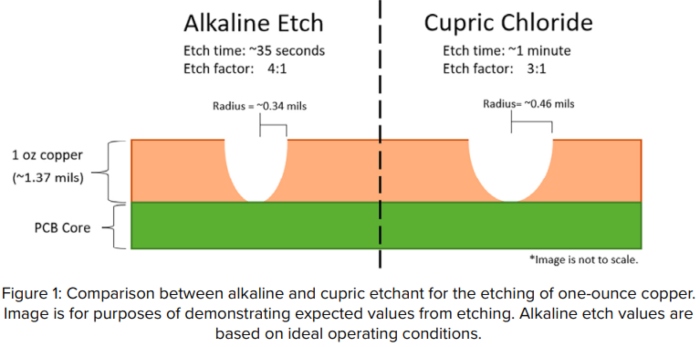
Alkaline etchant’s better etch factor opens the opportunity to maintain finer spaces and line widths when you are etching panels with thicker copper layers. Although alkaline can provide a great etch factor, a 4-to-1 ratio can only be obtained if the etchant is kept at its optimal condition, which is easier said than done.
Mastering the art of Cupric Chloride Etchant in PCB wet etching opens the door to unparalleled precision and control in circuit pattern creation. By adhering to proper etchant preparation, temperature regulation, immersion time, and safety precautions, engineers can craft intricate PCB designs with confidence. Embrace the power of Cupric Chloride Etchant and elevate your PCB manufacturing process to new heights of accuracy and efficiency.
In the realm of printed circuit board (PCB) manufacturing, Cupric Chloride Etchant stands as a powerful ally in achieving precision and control during the wet etching process. This chemical solution, composed of cupric chloride (CuCl2), enables engineers to selectively remove copper from PCB substrates, shaping intricate circuit patterns. In this blog, we will delve into the specifics of Cupric Chloride Etchant and provide valuable tips for its effective utilization in PCB wet etching machines.
Alkaline Etchant for PCB WET etching machine
As technology advances, so does our demand for smaller and more intricate electronic devices. Behind these cutting-edge gadgets lies the fascinating world of printed circuit boards (PCBs). Within PCB fabrication, the use of alkaline etchants has revolutionized the process of wet etching. In this blog, we will explore the ins and outs of alkaline etchants, uncovering the technique’s details for employing them in PCB wet etching machines.
What is Alkaline Etchant?
Alkaline etchant is a potent chemical solution utilized in the PCB manufacturing process. Composed mainly of alkaline substances such as sodium hydroxide (NaOH) or potassium hydroxide (KOH), this etchant is specially designed to selectively remove copper or other metallic materials from the PCB substrate. The purpose of this precise removal is to create specific circuit patterns and interconnections on the board.

Schematic diagrams illustrating the progressive alkaline etching process
Image from:https://www.researchgate.net/figure/Schematic-diagrams-illustrating-the-progressive-alkaline-etching-process-a-c-and-the_fig11_346886096
The Technique of Using Alkaline Etchant for PCB Wet Etching Machine:
- Preparing the PCB:
Before delving into the wet etching process, it is essential to ensure that the PCB is thoroughly cleaned and dried. Any contaminants or residues must be removed to guarantee optimal etching results.
- Etchant Composition:
Creating the right alkaline etchant solution is crucial for the success of the wet etching process. The proper concentration of the alkaline substance and any additional additives must be meticulously calculated and mixed. These additives may include stabilizers to control etch rates or improve solution stability.
- Immersion in Alkaline Etchant:
Once the etchant solution is prepared, the PCB is carefully immersed in the solution. For large-scale PCB manufacturing, automated wet etching machines are employed to ensure consistent and uniform etching across the substrate.
- Time and Temperature Control:
The key to achieving precise circuit patterns lies in controlling the etching time and temperature. The duration of immersion and the temperature of the etchant solution must be meticulously regulated to prevent over-etching or under-etching, both of which can lead to defective PCBs.
- Agitation:
In some cases, gentle agitation of the etchant solution is used to enhance the etching process further. Proper agitation ensures the even distribution of the etchant across the PCB surface, leading to uniform results.
- Rinse and Neutralization:
After the etching process is complete, the PCB is thoroughly rinsed with water to remove any remaining etchant solution. Additionally, the PCB may undergo a neutralization step to ensure the complete deactivation of the etchant.
Alkaline etchant has proven to be a game-changer in the world of PCB wet etching. By harnessing the power of this precise chemical solution, PCB manufacturers can create intricate circuit patterns, essential for modern electronic devices. Understanding the technique of using alkaline etchant, from its preparation to its application in wet etching machines, empowers engineers to deliver high-quality, reliable, and innovative PCBs for a myriad of technological applications.
Embrace the magic of alkaline etchant and dive into the realm of endless possibilities in PCB fabrication!
Chemical Etching Machine Wet Processing Equipment for PCB
What is the semiconductor wet process?
The semiconductor wet process, also known as wet etching or wet cleaning, refers to a set of techniques used in semiconductor manufacturing to modify or clean the surfaces of semiconductor materials using liquid chemicals. It involves the controlled application of specific chemical solutions onto the surface of a semiconductor wafer to achieve various purposes, such as etching, cleaning, or surface preparation.
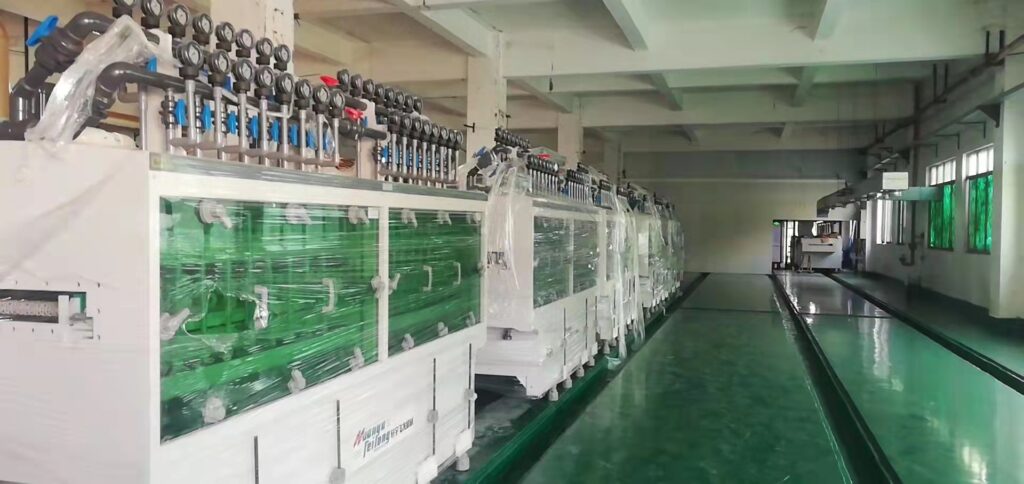
Wet etching is primarily used for selective removal of material layers from the surface of a semiconductor wafer. This process involves immersing the wafer into a liquid etchant, such as an acid or a base, that selectively reacts with the target material, dissolving it and leaving the desired pattern or structure intact. Wet etching is commonly used for creating patterns, such as trenches, wells, or isolation regions, in integrated circuits.
How much does t cost to produce PCB
- Design complexity: The more complex the design, with intricate circuitry, smaller trace widths, and finer pitch components, the higher the manufacturing cost. Complex designs may require advanced fabrication techniques or specialized equipment.
- Number of layers: PCBs can have single-layer, double-layer, or multilayer designs. Multilayer PCBs typically have higher manufacturing costs due to the additional layers and increased complexity in fabrication.
- Quantity: PCB manufacturers often offer volume discounts, meaning that producing a higher quantity of PCBs can reduce the cost per unit. However, prototyping or low-volume production may have higher per-unit costs.
- Materials: The choice of materials can impact the cost. High-quality materials or specialized laminates can be more expensive. Additionally, if specific materials are required for specialized applications or high-frequency designs, the cost may increase.
- Manufacturing options: Various manufacturing options, such as surface mount technology (SMT) assembly, through-hole assembly, or specialized processes like gold plating, can affect the cost. Additional processes like solder mask application, silkscreen printing, or panelization can also contribute to the overall cost.

Semiconductor(PCB) wet process equipment
Etching Machine: These machines are used for the chemical etching process to remove unwanted copper from the PCB surface. Spray etching machines, dip tanks, and conveyorized spray etching systems are commonly used for this purpose.
Developing Machine: Developing machines are used during the photoresist imaging process. They apply developer chemicals to remove the unexposed photoresist, revealing the desired circuit pattern.
Stripping Machine: Stripping machines are used to remove the remaining photoresist or solder mask after the etching process. They employ stripping chemicals to dissolve and clean the surface.
Plating Machine: Plating machines are utilized for the electroplating process to deposit a layer of metal, such as copper or gold, onto the PCB. These machines ensure controlled and uniform plating to create circuit traces or enhance conductivity.
Cleaning Machine: Cleaning machines are used for various cleaning steps throughout the PCB manufacturing process. They employ cleaning solutions to remove contaminants, residues, and particles from the PCB surface.
Rinse Machine: Rinse machines are employed to rinse the PCBs after each wet processing step to remove any remaining chemicals or contaminants. They typically use deionized water or other rinsing agents.
Difference between dry process and wet process
The main difference between dry process and wet process lies in the state of the materials or substances involved and the nature of the processes used. Here’s a general overview of the differences:
Dry Process:
- State of Materials: In a dry process, the materials involved are typically in a solid or gaseous state, with little or no involvement of liquid substances.
- Lack of Liquid Media: Dry processes generally do not involve the use of liquid media or solvents.
- Examples of Dry Processes: Dry processes can include techniques like dry etching (such as plasma etching or reactive ion etching), physical vapor deposition (PVD), dry cleaning, or dry surface treatment. These processes often rely on gas-phase reactions or physical mechanisms.
- Advantages: Dry processes can offer precise control, high resolution, and selectivity. They are often faster, more environmentally friendly, and can be more suitable for delicate or sensitive materials that may be affected by liquid exposure.
- Disadvantages: Dry processes may have limitations in terms of uniformity, compatibility with certain materials or substrates, and may require more specialized equipment.
Wet Process:
- State of Materials: Wet processes involve the use of liquid chemicals or solutions as a medium to carry out the desired reactions or treatments.
- Involvement of Liquid Media: Wet processes rely on immersing or applying liquid media to the materials being processed.
- Examples of Wet Processes: Wet processes can include wet etching, wet cleaning, chemical vapor deposition (CVD), electroplating, or wet surface treatment. These processes often involve chemical reactions and interactions between the materials and the liquid media.
- Advantages: Wet processes can offer excellent selectivity, high throughput, and good coverage over large areas. They are commonly used for bulk material removal, cleaning, and deposition of thin films.
- Disadvantages: Wet processes may require careful handling of hazardous chemicals, can introduce contaminants or require additional rinsing steps, and may have limitations in achieving high aspect ratios or sharp features.
Both dry and wet processes have their own advantages and are employed in various industries and applications. The choice between the two depends on factors such as the desired outcome, material compatibility, process requirements, and the specific manufacturing or treatment objectives.
Why wet process is important?
The wet process is important for several reasons, especially in the context of semiconductor manufacturing and other industries that involve precise material modification and cleaning. Some of the key reasons why the wet process is important include:
- Selective Material Removal: Wet etching is a crucial technique for selectively removing specific materials from the surface of semiconductor wafers or other substrates. This allows for the creation of intricate patterns, trenches, and isolation regions required for integrated circuits and microelectronics.
- Precision Surface Cleaning: Wet cleaning is essential for removing impurities, particles, and organic residues from the surface of wafers and other components. Clean surfaces are vital for ensuring the reliability and performance of semiconductor devices and other precision electronics.
- Compatibility with Delicate Materials: Wet processes are often more compatible with delicate or sensitive materials, as they do not subject the materials to high temperatures or harsh mechanical forces like some dry processes might. This is especially crucial in semiconductor manufacturing, where certain materials can be damaged or altered by dry processes.
- High Throughput: Wet processes can achieve high throughput, making them suitable for large-scale production in semiconductor fabrication facilities or other industries requiring mass production.
- Contamination Control: Wet processes can be designed to minimize contamination issues by using carefully controlled chemicals and rinsing steps, ensuring the purity of the final product.
- Low Cost: In some cases, wet processes can be more cost-effective than dry processes, especially when dealing with high-volume production.
- Uniformity: Wet processes can provide uniform deposition, etching, or cleaning over large areas, making them suitable for applications requiring consistent results across a substrate.
- Customization: The wet process can be tailored to specific requirements by adjusting chemical concentrations, process times, and temperature, enabling a wide range of applications and desired outcomes.
Due to these advantages, the wet process remains an integral part of semiconductor manufacturing, microelectronics, photovoltaic cell production, and various other industries requiring precise material modification and cleaning. While dry processes offer their own benefits, wet processes play a vital role in achieving the required levels of precision, uniformity, and compatibility with a diverse range of materials and applications.
Unveiling the Intricate Manufacturing Process of PCBs: Building the Backbone of Electronics
Discover the complex steps involved in creating printed circuit boards (PCBs) and their vital role in powering modern electronics.
The Intricate Manufacturing Process of PCBs: Building the Backbone of Modern Electronics
In the world of electronics manufacturing, there is a crucial component that often goes unnoticed but plays a vital role in powering the devices we rely on daily. Printed Circuit Boards (PCBs) serve as the backbone of modern electronics, providing the necessary platform for the intricate interconnections that bring electronic components to life. Behind the scenes, there is a complex and meticulous manufacturing process involved in creating these essential circuit boards.
At the forefront of this manufacturing process is the 569th Electronics Maintenance Squadron Circuit Board Manufacturing Shop, an integral part of providing combat-ready avionics parts and services to the warfighter. Located at the Warner Robins Air Logistics Complex, 402nd Electronics Maintenance Group in Robins Air Force Base, Georgia, this facility takes pride in its role in sustaining 75% of the Air Force organic workload.
Led by Bob Hillis, the supervisor of the 569th EMXS Circuit Board Manufacturing Shop, a dedicated team of ten individuals operates one of the two circuit board printing shops in the Department of Defense. Their primary focus lies in producing a wide array of printed circuit boards, including rigid, flex, multi-layer, single-sided, and double-sided designs, catering not only to the Air Force but also occasionally to other branches.
The manufacturing process commences with a thin sheet of laminate, which undergoes a series of intricate steps to transform it into a fully functional circuit board. Hillis explains that the process involves plating, drilling, imaging, development, stripping, and etching, as well as pressing and inspection, among other crucial steps. Each of these steps requires careful precision and adherence to strict production guidelines to ensure the highest quality standards are met.
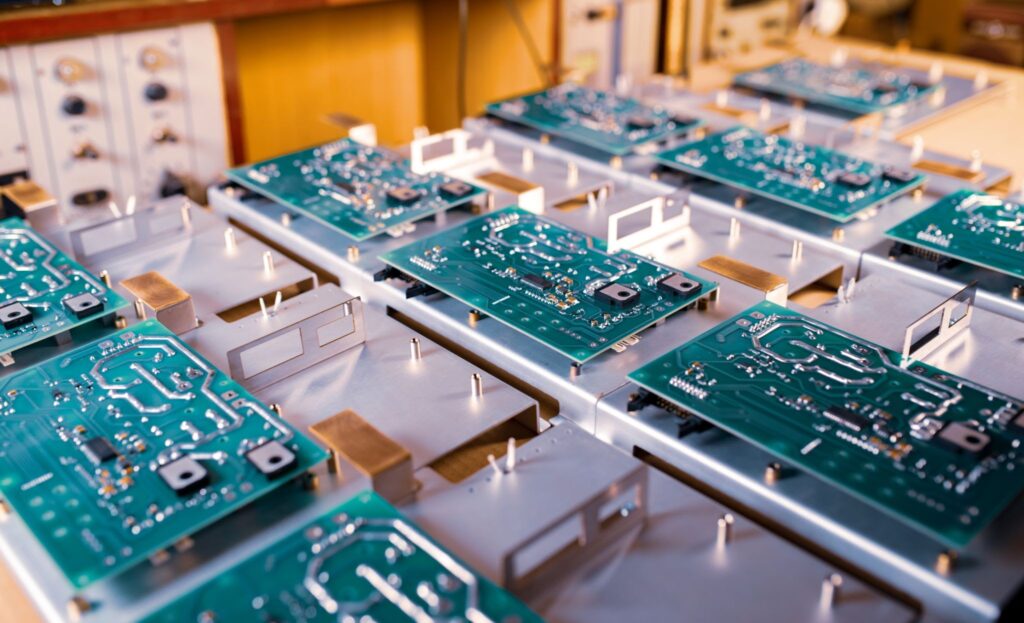
One particularly fascinating aspect of their work lies in the production of circuit boards for heavy lift trailers used to load bombers. These trailers, some of which have been in service for over 45 years, are a critical part of maintaining the U.S. Air Force bomber fleet’s nuclear and conventional mission. The 569th EMXS Circuit Board Manufacturing Shop is actively involved in their service life extension program, manufacturing the necessary circuit cards to update and enhance these trailers. For the 196-type trailers, 133 circuit cards are required, while the 204-type trailers call for 32 completed cards.
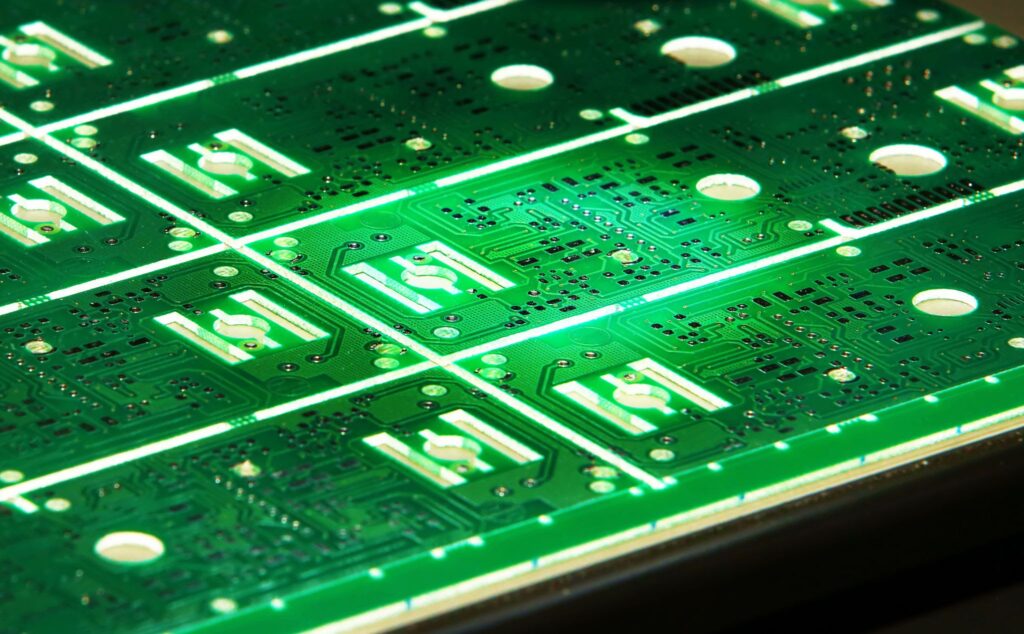
To stay at the forefront of the circuit board industry, the team at the 569th EMXS Circuit Board Manufacturing Shop emphasizes continuous training and improvement. Regularly attending conferences, seminars, and training sessions, they strive to enhance their processes and remain up-to-date with the latest advancements in the field. This commitment to ongoing education ensures that they are equipped with the necessary knowledge and skills to deliver high-quality circuit boards that meet the demanding standards of the military.
Manufacturing printed circuit boards for the nation’s military is a responsibility that the team takes great pride in. Hillis acknowledges the weight of their role but finds immense satisfaction in knowing that their work contributes to critical assets for global warfighters. Whether manufacturing new circuit boards or repairing existing ones, the 569th EMXS Circuit Board Manufacturing Shop recognizes the honor and importance of their contribution to the defense and security of the nation.
While the manufacturing process of PCBs may be hidden from the eyes of the end consumer, it is a fascinating journey of precision and expertise. From the initial stages of plating and drilling to the final inspection and testing, each step is a testament to the skill and dedication of the individuals involved. As we continue to rely on increasingly advanced electronics in our daily lives, let us not forget the intricate manufacturing process behind the circuit boards that power our devices and shape the world of technology.
Essential Machinery for PCB Production: Protection Act Compliance
The U.S. “Protection of Circuit Boards and Substrates Act” is a crucial piece of legislation that aims to safeguard the integrity and security of circuit boards and substrates used in various electronic devices. With the increasing demand for advanced electronic products, many businesses in the United States are considering expanding or building PCB production lines. In this blog, we will provide an interpretation of the Protection of Circuit Boards and Substrates Act, and delve into the essential machinery required in a PCB production line, including PCB etching machines, PCB cleaning machines, PCB drilling machines, PCB browning machines, PCB sandblasting machines, PCB polishing machines, PCB oxidation resistance machines, PCB desoldering machines, PCB stripping machines, and PCB developing exposing machines. This information will help visitors who are motivated to purchase these machines and establish or expand their own PCB production lines.
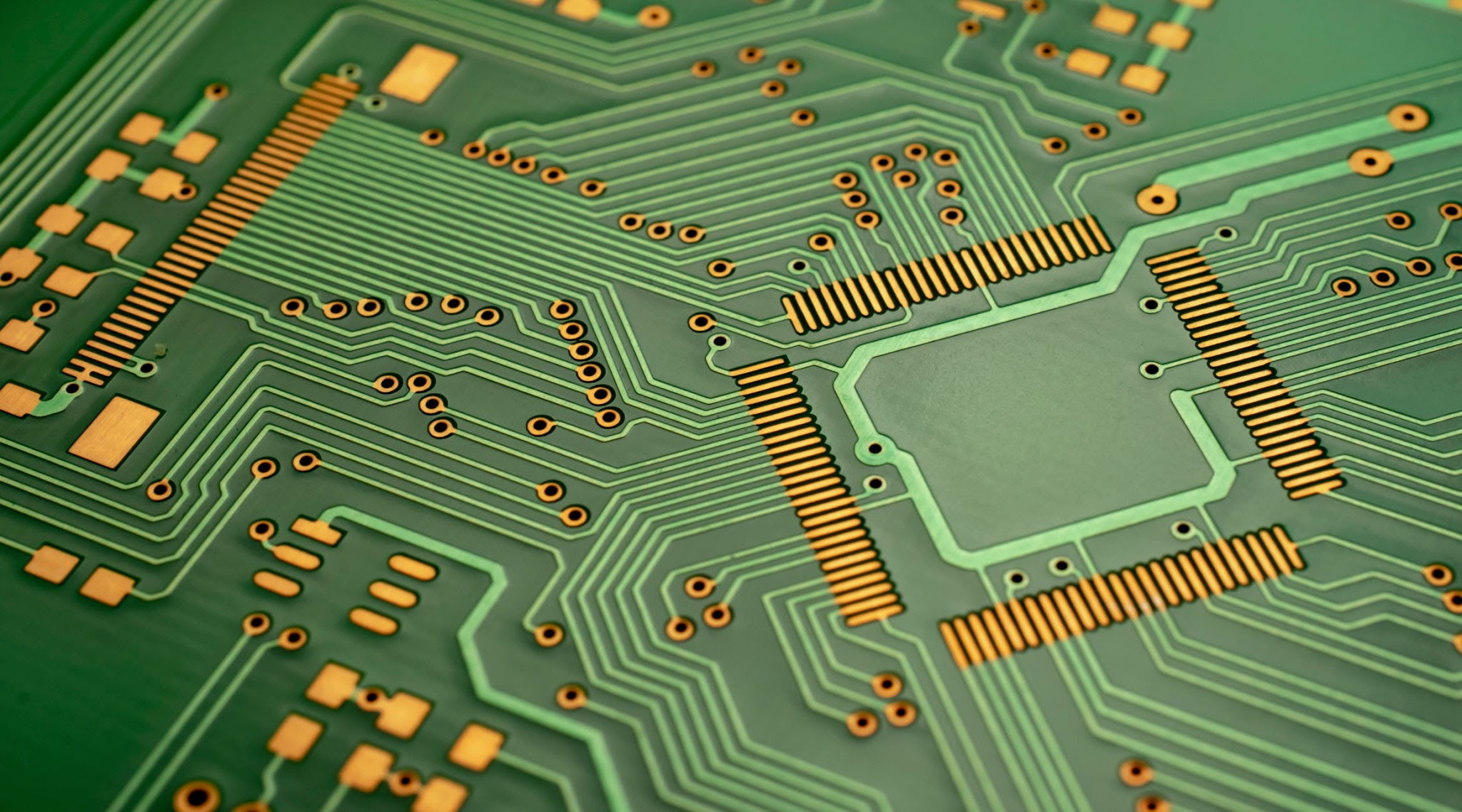
The “Protection of Circuit Boards and Substrates Act” is a significant legislation aimed at ensuring the security and integrity of circuit boards and substrates used in electronic devices within the United States. The act recognizes the critical role played by circuit boards and substrates in the functioning of electronic products and seeks to prevent unauthorized modifications, counterfeiting, and tampering that could compromise their performance or pose security risks.
The act encompasses various provisions and requirements that manufacturers, distributors, and users of circuit boards and substrates must adhere to in order to comply with the law. Some key aspects of the act include:
- Counterfeit Prevention: The act emphasizes the need to combat the production and distribution of counterfeit circuit boards and substrates. It prohibits the manufacturing, sale, or use of counterfeit components and mandates stringent measures to ensure the authenticity of these critical electronic parts.
- Traceability and Documentation: The act emphasizes the importance of traceability and documentation throughout the supply chain. Manufacturers and distributors are required to maintain detailed records of the origin, manufacturing process, and distribution of circuit boards and substrates. This information helps establish accountability and facilitates effective quality control and product recalls if necessary.
- Quality Assurance: The act promotes the implementation of rigorous quality assurance measures throughout the production process. Manufacturers are encouraged to adopt industry best practices and adhere to recognized standards to ensure the reliability, performance, and safety of circuit boards and substrates.
- Security Measures: The act recognizes the need to safeguard electronic devices against potential security threats. It encourages the use of secure designs, authentication mechanisms, and encryption technologies to protect the integrity of circuit boards and substrates. This is particularly relevant in applications where the confidentiality of data or critical operations are at stake.
- Compliance and Enforcement: The act establishes mechanisms for compliance verification and enforcement. Regulatory authorities are empowered to conduct inspections, audits, and investigations to ensure that manufacturers and distributors are in compliance with the provisions of the act. Non-compliance can result in penalties, fines, or other legal consequences.

The “Protection of Circuit Boards and Substrates Act” reflects the growing importance of circuit boards and substrates in today’s interconnected and technology-driven world. By establishing guidelines and regulations, the act aims to foster trust among consumers and businesses, protect intellectual property, and promote the safe and reliable use of electronic devices.
For businesses involved in the establishment or expansion of PCB production lines, understanding and adhering to the requirements outlined in the act is essential. Compliance with the act not only ensures legal adherence but also demonstrates a commitment to quality, security, and customer satisfaction.
The Protection of Circuit Boards and Substrates Act focuses on safeguarding the manufacturing, distribution, and use of circuit boards and substrates within the United States. The act imposes regulations to prevent counterfeiting, tampering, and unauthorized modifications to these critical components, ensuring the reliability and security of electronic devices. It is important for businesses engaged in PCB production to adhere to the requirements specified in this act to maintain compliance with the law and protect consumer trust.
Dragon Etching Essential Machinery in a PCB Production Line:
- PCB Etching Machine: PCB etching machines are vital in the production process as they facilitate the removal of unwanted copper from the substrate, creating the desired circuitry. These machines use chemical processes to dissolve the excess copper, leaving behind the required copper traces for circuit connections.
- PCB Cleaning Machine: PCB cleaning machines are used to remove any contaminants or residues that accumulate during the manufacturing process. They employ various cleaning methods such as ultrasonic cleaning, brush cleaning, and chemical cleaning to ensure the cleanliness and reliability of the circuit boards.
- PCB Drilling Machine: PCB drilling machines are responsible for creating holes in the circuit boards to accommodate electronic components. These machines utilize high-speed rotating drill bits to accurately drill holes of varying sizes, ensuring precise placement and alignment.
- PCB Browning Machine: PCB browning machines, also known as brown oxide machines, are used to create a protective layer on the exposed copper surfaces of the circuit boards. This layer prevents oxidation and enhances the conductivity of the copper traces, improving the overall performance and longevity of the PCB.
- PCB Sandblasting Machine: PCB sandblasting machines are employed for surface preparation, primarily to remove solder mask or copper from specific areas. This process is crucial for creating solder pads and ensuring proper solder adhesion during component assembly.
- PCB Polishing Machine: PCB polishing machines are used to refine the surface finish of circuit boards. They remove any imperfections, such as rough edges or burrs, resulting from the manufacturing process, and provide a smooth and uniform surface for further processing or component placement.
- PCB Oxidation Resistance Machine: PCB oxidation resistance machines apply protective coatings to the circuit boards, safeguarding them against environmental factors such as humidity, moisture, and corrosive substances. These coatings enhance the reliability and durability of the PCBs, ensuring their longevity in demanding applications.
- PCB Desoldering Machine: PCB desoldering machines are essential for repairing or reworking PCBs. They allow the removal of electronic components without damaging the board, enabling efficient repairs and replacements during the production process or after device assembly.
- PCB Stripping Machine: PCB stripping machines are used to remove unwanted solder masks, ensuring accurate solder pad exposure
PCB Etching Machine Cleaning Solution
PCB etching machines are essential for manufacturing high-quality printed circuit boards (PCBs). Over time, these machines can become contaminated with chemicals and residue from the etching process, which can affect the quality of the etching and potentially damage the machine. To keep your PCB etching machine in top condition, regular cleaning is essential. In this article, we will discuss some tips for using a cleaning solution to clean your PCB etching machine.
- Selecting the Right Cleaning Solution: There are several types of cleaning solutions available for cleaning PCB etching machines. It is important to choose a cleaning solution that is safe for the machine and effective at removing the contaminants. Always refer to the manufacturer’s guidelines and recommendations when selecting a cleaning solution.
- Protecting Yourself: Before using the cleaning solution, ensure that you are wearing appropriate personal protective equipment (PPE), such as gloves, eye protection, and respiratory protection, if necessary. Cleaning solutions can be corrosive and hazardous, so it is essential to follow proper safety precautions.
- Preparing the Solution: Once you have selected a suitable cleaning solution, prepare it according to the manufacturer’s instructions. Typically, the solution will need to be diluted with water to achieve the desired concentration. Use distilled or deionized water, as tap water may contain impurities that can affect the cleaning process.
- Cleaning the Machine: To clean the PCB etching machine, apply the cleaning solution to a cloth or sponge and gently wipe down the surfaces. Pay particular attention to areas that are prone to contamination, such as the etching tank, nozzles, and pipes. Avoid using abrasive materials or scrubbers that could damage the machine.
- Rinsing and Drying: After cleaning the machine with the solution, rinse the surfaces thoroughly with clean water to remove any remaining residue. Use a clean cloth or paper towel to dry the machine and remove any excess water. It is essential to ensure that the machine is completely dry before using it again, as moisture can cause corrosion and damage to the machine.
In conclusion, cleaning your PCB etching machine with a suitable cleaning solution is essential for maintaining the quality of your PCBs and prolonging the life of your machine. By following these tips, you can help ensure that your machine is clean, safe, and functioning optimally, producing high-quality PCBs that meet your specifications and requirements.
